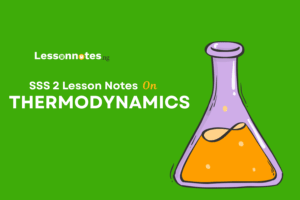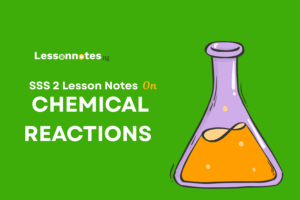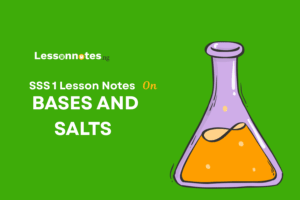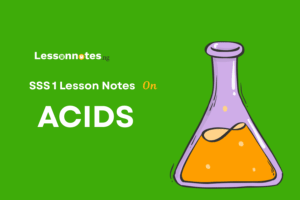Halogens SS2 Chemistry Lesson Note
Download Lesson NoteTopic: Halogens
Halogens (salt formers) are found in group VII of the periodic table. They are the most reactive nonmetals. They have seven valence electrons, they exist as diatomic molecules, and they are coloured and ionized to form univalent negative ions. They form electrovalent compounds with metals. In the group are chlorine, fluorine, bromine, iodine and astatine.
ELECTRONIC CONFIGURATION OF HALOGENS
The halogens meaning salt makers are found in group VII of the periodic table. The electronic configuration of the halogens is one electron short of the noble gas structure (i.e. contains seven electrons on their outermost shells), and the chemistry of the group is dominated by the tendency to complete the octet arrangement by receiving an electron. The electronic configurations of the halogens are shown below:
Fluorine = 9: 1s² 2s² 2p⁵
Chlorine = 17: 1s² 2s² 2p⁶ 3s² 3p⁵
Bromine = 35: 1s² 2s² 2p⁶ 3s² 3p⁶ 3d¹⁰ 4s² 4p⁵
Iodine = 53: 1s² 2s² 2p⁶ 3s² 3p⁶ 3d¹⁰ 4s² 4p⁶ 4d¹⁰ 5s² 5p⁵
PHYSICAL PROPERTIES OF THE HALOGENS
- They are usually univalent, and easily accept one electron from other atoms to form ionic compounds (especially from metals e.g. Na & K). They also share electrons with themselves or with nonmetals to form covalent compounds.
- They exist in their natural states as nonpolar diatomic molecules.
- Fluorine and chlorine are gases, bromine is a liquid and iodine is a solid.
- The halogens are coloured, with a typical penetrating odour. The colours deepen down the group.
- Fluorine is pale yellow, chlorine is greenish-yellow, bromine is red and iodine is violet.
- They are volatile substances. Their volatility decreases down the group.
- All the halogens except fluorine, dissolve to some extent in water, fluorine reacts with water to give oxygen and hydrogen fluoride.
CHEMICAL PROPERTIES OF THE HALOGENS
- The halogens are very reactive elements. Their reactivity decreases down the group. Fluorine is the most reactive halogen. They are also strongly electronegative. Their Electronegativity decreases down the group.
- As oxidizing agents. Halogens are strong oxidizing agents. They do so by accepting electrons and forming halide ions, especially in the reaction with metals. The oxidizing power decreases down a group.
Reaction with metals: Halogens react with metals to form ionic compounds. 2Na(s) + F2(g) → 2NaF(s)
- Reaction with hydrogen: Fluorine explodes with hydrogen even in the dark, chlorine reacts slowly in the dark but explodes in bright sunlight, bromine reacts with hydrogen in the presence of platinum catalyst; while iodine reacts partially with hydrogen on heating. Example
H2(g) + Cl2(g) → 2HCl(g)
- The stability of the hydrogen halides decreases down the group.
Hydrogen fluoride is a liquid with a boiling point of 19°C. The other hydrogen halides are gases.
- Reaction with water: Fluorine reacts vigorously with water to give off oxygen gas. Chlorine reacts very slowly with water to give a mixture of hydrochloric acid and oxochlorate (I) acid which later decomposes to give hydrochloric acid and oxygen gas. The oxygen gas given off by the oxochlorate (I) acid is responsible for the bleaching action of moist chlorine gas and chlorine water.
H2O(g) + Cl2(g) → HCl(aq) + HOCl(aq)
CHLORINE
Chlorine is the most important element in the halogen family. It does not occur as a free element in nature because it is too reactive. It is usually found in a combined state as chlorides.
LABORATORY PREPARATION OF CHLORINE
- By the oxidation of concentrated HCl with strong oxidizing agent such as MnO2 or KMnO4
MnO2(s) + 4HCl(aq) → MnCl2(aq) + 2H2O(l) + Cl2(g

2. By heating concentrated H2SO4 with a mixture of NaCl and MnO2
2NaCl(s) + MnO2(s) + 2H2SO4(aq) → Na2SO4(aq) + MnSO4(aq) + H2O(l) + Cl2(g)
INDUSTRIAL PREPARATION
Chlorine is manufactured industrially by the electrolysis of brine and molten NaCl, MgCl2 or CaCl2.
PHYSICAL PROPERTIES
- Chlorine is a greenish-yellow gas with an unpleasant choking smell.
- It is a poisonous gas.
- It is about 2.5 times denser than air.
- It can be liquefied under a pressure of about 6 atm.
- It is moderately soluble in water.
CHEMICAL PROPERTIES
- It is very reactive and tends to attain stability by forming electrovalent compounds with metals and single covalent bond compounds with non-metals.
2Na(s) + Cl2(g) → 2NaCl(s)
Cl2(g) + H2(g) → 2HCl(g)
- It displaces other halogens from solution of their acids and salts
Cl2(g) + NaI(aq) → 2NaCl(aq) + I2(g)
- It combines directly with other elements except oxygen, nitrogen carbon and noble gases; to form chlorides
Ca(s) + Cl2(g) → CaCl2(s)
- It has a very strong affinity for hydrogen; it removes hydrogen from its compounds.
C10H12(l) + 8Cl2(g) → 10C(s) + 16HCl(g)
- It is a powerful oxidizing agent: it oxidizes green Fe2+ to yellow Fe3+
2FeCl2(aq) + Cl2 → 2FeCl3(aq)
- It has a bleaching action: in the presence of water, chlorine bleaches most dyes and inks except printer ink. The bleaching action of chlorine is due to its ability to react with water to form oxochlorate (I) acid which decomposes to release oxygen which oxidizes the dye to form a colourless compound.
H2O(l) + Cl2(g) → HCl(aq) + HOCl(aq)
HOCl(aq) → HCl(aq) + [O]
Dye + [O] → [Dye + O]
Coloured Colourless
- It reacts with a hot concentrated NaOH solution to give a mixture of trioxochlorate (V) and chloride of the metal.
6NaOH + 3Cl2(g) → NaClO3(aq) + NaCl(aq) + H2O(l)
Sodium trioxochlorate (V)
- With a cold dilute solution of NaOH, a pale yellowish mixture of oxochlorate (I) and chloride of the metal is formed.
2NaOH(aq) + Cl2(g) → NaOCl(aq) + NaCl(aq) + H2O(l)
- It reacts with slaked lime solutions to produce bleaching powder
Ca(OH)2(aq) + Cl2(g) → CaOCl2.H2O(s)
Bleaching powder
TEST FOR CHLORINE
- It turns damp blue litmus paper pink and then bleaches it. It is an acidic gas.
- It turns a damped starch-iodide dark blue. Chlorine turns starch-iodide paper blue because it displaces iodine from the iodide. The iodine liberated then turns the starch blue.
USES OF CHLORINE
- It is a powerful germicide [due to its oxidizing nature].
- It is used as a bleaching agent for cotton, wool, pulp etc.
- It is used in the manufacture of polyvinyl chloride (PVC) and synthetic rubber.
- It is used in the manufacture of organic compounds e.g. CHCl3, CCl4.
- It is used in producing KClO3, for making matches and fireworks.
- It is used for making NaClO3, a weed killer.
- It is used for making domestic antiseptics e.g. acidified NaClO solution.
COMPOUNDS OF CHLORINE
- Hydrogen Chloride
Hydrogen chloride (marine-acid gas) exists as a gas at room temperature. It dissolves in water to form hydrochloric acid. It occurs in traces in the air as an industrial by-product and is considered an air pollutant, but it can be easily washed down as acid rain since it is very soluble in water.
LABORATORY PREPARATION
The gas is prepared by the action of hot concentrated H2SO4 on any soluble chloride. Example 2NaCl(s) + H2SO4(aq) → Na2SO4(aq) + 2HCl(g)
Note: NaHSO4 is first formed at a lower temperature and later at a higher temperature HCl gas is formed. The gas is dried by passing it through concentrated H2SO4 in another flask and collected.
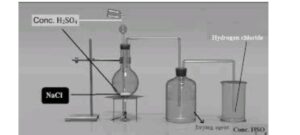
INDUSTRIAL PREPARATION
Pure HCl gas can be produced on a large scale by a direct combination of hydrogen and chloride gas obtained from the electrolysis of brine.
H2(g) + Cl2(g) → 2HCl(g)
PHYSICAL PROPERTIES
- Pure HCl gas is colourless and has a sharp irritating smell
- It turns damp blue litmus paper red.
- It is about 1.25 times denser than air.
- It is very soluble in water, forming aqueous HCl acid.
- It is readily dissolved in non-polar solvents like chloroform and toluene, but the solution does not conduct electricity and has no acidic properties because hydrogen chloride which is a covalent molecule does not ionize when it dissolves in non-polar solvents. But it dissolves in water and ionizes. The ions formed in aqueous solution are responsible for the acidic property and conductivity of its aqueous solution.
- It forms misty fumes in moist air because it dissolves in the moisture to form tiny droplets of HCl acid.
- It does not support combustion.
CHEMICAL PROPERTIES
- It combines directly with NH3 and produces white fumes of ammonium chloride
HCl(g) + NH3(g) → NH4Cl(s)
- It reacts with various heated metals to form their respective chloride and hydrogen
Zn(s) + 2HCl(g) → ZnCl2(s) +H2(g)
TEST FOR HYDROGEN CHLORIDE
A gas rod that has been dipped in ammonia solution is brought near the gas jar containing the unknown gas, if there are dense white fumes on the glass rod, then the gas is hydrogen chloride gas.
A few drops of silver trinitrate (V) are added to the gas jar containing the unknown gas and shaken. If a white precipitate of silver chloride is observed, then the gas is hydrogen chloride gas.
Chlorides
Chlorides are normal salts formed when metallic ions replace the hydrogen ion in hydrochloric acid. Chlorides are prepared by a neutralization reaction. Chlorides are soluble in water except a few.
Soluble chlorides: NaCl, NH4Cl, KCl
Insoluble chlorides: CuCl2, AgCl, PbCl2, CaCl2 etc
PROPERTIES
- Chlorides are not decomposed by heat. They can only be recovered from solution by evaporation to dryness or sometimes by crystallization.
- They react with hot concentrated tetraoxosulphate (VI) acid to produce hydrogen chloride gas.
2NaCl(s) + H2SO4(aq) → Na2SO4(aq) + 2HCl(g)
- On heating a chloride with concentrated tetraoxosulphate (VI) in the presence of a strong oxidizing agent, chlorine is produced.
ZnCl2(s) + KMnO4(s) + 2H2SO4(aq) → ZnSO4(aq) + K2SO4(aq) + 2MnO2(aq) + 2H2O(l) + Cl2(g)
Test For Chlorides
The test solution is acidified with dilute trinitrate (V) acid to prevent precipitation of other salts. A few drops of AgNO3(aq) are then added to the acidified solution in a test tube, a white precipitate of AgCl which readily dissolves in excess NH3(aq) solution indicates the presence of a chloride.







